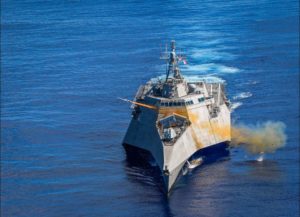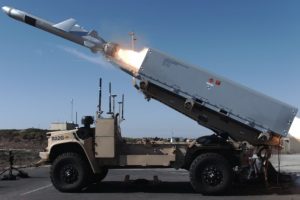The Navy recently issued a sources sought notice seeking companies that can manufacture the Naval Strike Missile (NSM) as it eyes possible multi-year procurement.
The notice said Naval Sea Systems Command is specifically looking to identify potential sources capable of building the Over the Horizon – Weapons System (OTH-WS) Encanistered Missiles (EM), which consists of a Naval Strike Missile encased in a firing canister made of a flight vehicle mechanically and electrically connected within the canister. The system also includes the launch mechanism, operator interface, and a fire control system.

This comes after the House and Senate negotiators revealed the compromise fiscal year 2023 defense authorization bill that allows for multiyear procurement authority on up to 1,250 Naval Strike Missiles. The bill also upped the Navy’s $59 million requested for NSM with an additional $200 million to use for advanced procurement (Defense Daily, Dec. 7).
The Navy said the OTH-WS provides a long range anti-ship OTH Offensive Anti-Surface Warfare (OASuW) capability “to counter identified threat gaps by providing the ability to engage surface threats utilizing advanced seeker and guidance systems capable of delivering a mission kill in extremely hostile environments.”
OTH-WS is meant to act as a stand-alone system without only minimal integration work onto naval platforms.
The service underscored that a “key performance characteristic” of OTH-WS is being able to be fired without guidance after launch and hitting the target without the launcher being in line-of-sight of the target.
The NSM was originally developed and built by Norway’s Kongsberg. The U.S. version of NSM has thus far had Kongsberg work with Raytheon Technologies [RTX] to deliver NSM for the OTH capability on Littoral Combat Ships and the future Constellation-class frigates.
The notice described the NSM as a “ bank-to-turn missile with an imaging infrared seeker and employs an armor-piercing warhead optimized for anti-surface warfare.”
The Navy said NSM can also be used for land attack missions because it can climb and descend with the terrain, with the Marine Corps having tested a mobile land-based configuration in recent years.
In April 2021, the Marine Corps conducted a live fire test launching a Naval Strike Missile from a modified unmanned Joint Light Tactical Vehicle (JLTV) against a sea surface target (Defense Daily, April 30, 2021).
A second test that year during the Navy’s Sink at Sea Live Fire Training Exercises in Hawaii included a direct hit on a sea target from the modified JLTV, called a Remotely Operated Ground Unit for Expeditionary (ROGUE) Fires vehicle (Defense Daily, Aug. 18, 2021).
The Marine Corps designated its land-based NSM as the Ground Based Anti-Ship Missile (GBASM) program, which is entering the system test and operability phase, the notice said.

This market survey notice said potential sources to produce the Naval Strike Missile and associated components “should be capable of supplying the entire quantity of Encanistered Missiles (EM)” under a firm fixed price contract. Deliveries are expected to start in fiscal year 2026.
The notice provided a preliminary yearly quantity requirement, subject to change: 119 units in FY ‘24, 126 units in FY ‘25, 90 units in FY ‘26, and 127 units in FY ‘27. This is a total of 472 OTH-WS encanistered Naval Strike Missiles over four years.
Each respondent to this notice has to provide evidence it can produce the NSMs in accordance with a qualified Technical Data Package (TDP) the Navy has and they have the personnel trained and experienced in handling the system.
TDPs consist of the design information and support needed for the government to award separate vendors contracts to produce the same product. The Navy contract for the Constellation-class frigates includes a TDP that it may use to award a second shipbuilder for faster shipbuilding rates in the future.
Responses to this request are due by Dec. 23.